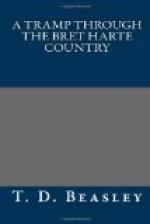In common with all the old mining towns — though I was unaware of it at the time — Angel’s, as it is usually called, is situated in the ravine where gold was first discovered. It straggles down the gulch for a mile and a half. There are a number of pretty cottages clinging to the steep hillsides, surrounded with flowers and trees, the whole effect being extremely pleasing. I registered at the Angel’s Hotel, built in 1852. Across the street is the Wells Fargo building, erected about the same time and of solid stone, as is the hotel. Nothing on this trip surprised me more than the solidity of the hotels and stores built in the early fifties. Instead of the flimsy wooden structures I had imagined, I found, for the most part, thick stone walls. It was evident the Pioneers believed in the permanence of the gold deposits in the Mother Lode. Possibly they were right; Angel’s is anything but a dead town to-day. The Utica, Angel’s and Lightner mines give employment to hundreds of men.
In the afternoon I visited the Bret Harte Girls’ High School. It is a very simple frame building, on the summit of a hill overlooking the town. The man who directed me how to find it, I discovered had not the remotest idea who Bret Harte might be; “John Brown” would have answered the purpose equally as well. In fact, all through the seven counties I traversed — Tuolumne, Calaveras, Amador, El Dorado, Placer, Nevada and Yuba — I found Bret Harte had left but a hazy and nebulous impression. Mark Twain, Prentice Mulford, Horace Greeley, Bayard Taylor, even “Dan de Quille,” seemed better known.
The next morning I started for Sonora. In seven miles I came to the Stanislaus River, running in a deep and splendid canon. The river here is spanned by a fine concrete bridge, built jointly by Tuolumne and Calaveras Counties, between which the river forms the dividing line. In the bottom of the canon is the Melones mine, with a mill operating one hundred stamps. The main tunnel is a mile and a half in length; the longest mining tunnel in the State, I was told.
A steep pull of two miles out of the canon brought me to Tuttletown. Here I stayed several hours, for the interest of the whole trip, so far as Bret Harte was concerned, centered around this once celebrated camp, and Jackass Hill, on which, at one time, lived James W. Gillis, the supposed prototype of “Truthful James.” He died a few years ago, but his brother, Stephen R. Gillis, is living there to-day, and after some little difficulty I succeeded in finding his house.
Mr. Gillis scouts the idea that his brother “Jim” was the “Truthful James” of Bret Harte. He said that in reality it was J. W. E. Townsend, known in old times as “Alphabetical Townsend,” also by the uncomplimentary appellation of “Lying Jim.” According to Mr. Gillis, Bret Harte made but one visit to Tuttletown. He arrived there one evening “dead broke” and James put him up for the night and lent him money to help him




